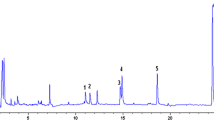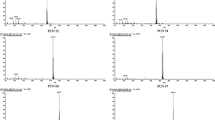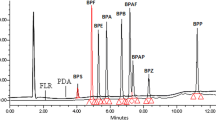Abstract
A method was developed for the determination of Aroclor 1254 in water samples using polystyrene–divinylbenzene (PS–DVB) solid-phase extraction (SPE) and gas chromatography (GC). The PS–DVB sorbent demonstrated good recoveries of Aroclor 1254 when sulfuric acid (1:1, v:v) was added to the samples. Sample quantification was performed using gas chromatography with a parallel column and dual electron capture detector. Factors in extraction method procedures were optimized, including sample pH, elution solvent, eluting volume and breakthrough volume. With the 1000 ml sample acidified to pH 1.0, a 6.0 ml n-hexane/ethyl acetate (1:1, v:v) elution solvent, and gas chromatographic determination, the recoveries of Aroclor 1254 in spiked water samples ranged from 90.6 to 104%. Across testing days, repeatability ranged from 4.7 to 7.6%. The method detection limit was 0.053 μg/L. PS–DVB exhibited a broader pH stability range, satisfactory recoveries, and good repeatability for Aroclor 1254 extraction. The results indicate that these methods can be used to analyze trace amounts of Aroclor 1254, and represent a new analytical approach for determining polychlorinated biphenyls in water samples.




Similar content being viewed by others
References
Suzuki T, Yaguchi K, Suzuki S, et al. Monitoring of phthalic acid monoesters in river water by solid-phase extraction and GC-MS determination. Environ Sci Technol. 2001;35(18):3757–63.
Olenycz M, Sokołowski A, Niewińska A, et al. Comparison of PCBs and PAHs levels in European coastal waters using mussels from the Mytilus edulis complex as biomonitors. Oceanologia. 2015;57(2):196–211.
Javedankherad I, Esmaili-Sari A, Bahramifar N. Levels and distribution of organochlorine pesticides and polychlorinated biphenyls in water and sediment from the international Anzali wetland, north of Iran. B Environ Contam Toxicol. 2013;90(3):285–90.
Cui S, Fu Q, Guo L, et al. Spatial-temporal variation, possible source and ecological risk of PCBs in sediments from Songhua River, China: effects of PCB elimination policy and reverse management framework. Mar Pollut Bull. 2016;106(1–2):109–18.
Erickson MD. Analytical chemistry of PCBs. 2nd ed. Boca Raton: CRC Press; 1997.
Kaya D, Imamoglu I, Sanin FD, et al. Potential risk reduction of Aroclor 1254 by microbial dechlorination in anaerobic Grasse river sediment microcosms. J Hazard Mater. 2016;321:879–87.
Flahr L, Michel NL, Zahara A, et al. Developmental exposure to Aroclor 1254 alters migratory behaviour in juvenile European starlings (Sturnus vulgaris). Environ Sci Technol. 2015;49(10):6274–83.
Zhong Y, Guo P, Wang X, et al. Aroclor 1254 inhibits cell viability and induces apoptosis of human A549 lung cancer cells by modulating the intracellular Ca2+ level and ROS production through the mitochondrial pathway. J Environ Sci Health Part A Toxicol Hazard Subst Environ Eng. 2015;50(8):806–13.
Aydın S, Erkekoğlu P, Kocer-Gumusel B, et al. Effects of selenium status on DNA damage in the lymphocytes and sperms of Aroclor 1254-exposed rats. Toxicol Lett. 2015;238(2):S299.
Jonsson S, Boren H. Analysis of mono- and diesters of o-phthalic acid by solid-phase extractions with polystyrene–divinylbenzene-based polymers. J Chromatogr A. 2002;963:393–400.
Usepa. Organochlorine pesticides and pcbs. Washington, DC: Environmental Protection Agency; 2014.
Hennion MC. Solid-phase extraction: method development, sorbents, and coupling with liquid chromatography. J Chromatogr A. 1999;856(1–2):3–54.
Leon-Gonzalez ME, Perez-Arribas LV. ChemInform abstract: chemically modified polymeric sorbents for sample preconcentration. J Chromatogr A. 2001;902(1):3–16.
Jara S, Lysebo C, Greibrokk T, et al. Determination of phthalates in water samples using polystyrene solid-phase extraction and liquid chromatography quantification. Anal Chim Acta. 2000;407(1–2):165–71.
Jonsson S, Bor Eacute, et al. Analysis of mono- and diesters of o-phthalic acid by solid-phase extractions with polystyrene-divinylbenzene-based polymers. J Chromatogr A. 2002;963(1–2):393–400.
Eskandari H, Naderi-Darehshori A. Preparation of magnetite/poly(styrene-divinylbenzene) nanoparticles for selective enrichment-determination of fenitrothion in environmental and biological samples. Anal Chim Acta. 2012;743(18):137–44.
Quintana MC, Ramos L. Sample preparation for the determination of chlorophenols. TrAC Trends Anal Chem. 2008;27(5):418–36.
Storrhansen E. Simultaneous analysis of 32 pcb-congeners on two capillary columns operated in parallel with a glass-split. Int J Environ Anal Chem. 1991;43(4):253–66.
Pichon V. Solid-phase extraction for multiresidue analysis of organic contaminants in water. J Chromatogr A. 2000;885(1–2):195–215.
Liang R, Zhao Y, Su Y, et al. Determination of hydroxylated polychlorinated biphenyls by offline solid-phase extraction-liquid chromatography-tandem mass spectrometry using a molecularly imprinted polymer as a sorbent for sample preconcentration. Talanta. 2015;144:115–21.
Kimata K, Hosoya K, Kuroki H, et al. Selectivity of electron-donor- and electron-acceptor-bonded silica packing materials for hydrophobic environmental contaminants in polar and non-polar eluents. J Chromatogr A. 1997;786(2):237–48.
Echols KR, Gale RW, Feltz K, et al. Loading capacity and chromatographic behavior of a porous graphitic carbon column for polychlorinated biphenyls. J Chromatogr A. 1998;811(1–2):135–44.
Sychov CS, Davankov VA, Proskurina NA, et al. The unique selectivity of π-interactions for solid-phase extraction. LC•GC Europe. 2009;22(1):1–8.
USEPA. Definition and procedure for the determination of the method detection limit. US Code of Federal Regulations; Guidelines establishing test procedures for the analysis of pollutants-appendix B, part 136, Title 40. 1999.
Acknowledgements
The authors gratefully acknowledge the financial support provided by Environmental Monitoring and Research Foundation of Jiangsu Province (No. 1621).
Author information
Authors and Affiliations
Corresponding author
About this article
Cite this article
Shen, F., Xu, YJ., Wang, Y. et al. Determination of Aroclor 1254 in Water Samples Using Polystyrene–Divinylbenzene Solid-Phase Extraction and Gas Chromatography. J. Anal. Test. 2, 306–311 (2018). https://doi.org/10.1007/s41664-018-0063-7
Received:
Revised:
Accepted:
Published:
Issue Date:
DOI: https://doi.org/10.1007/s41664-018-0063-7




